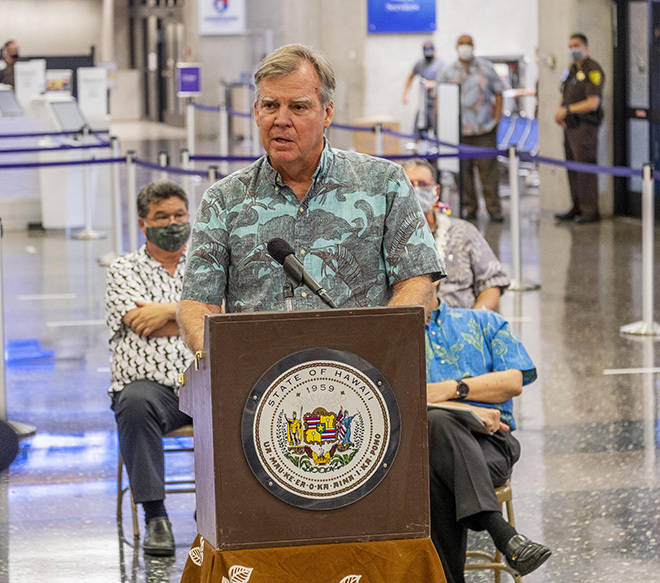Officials say Hawaii is ready for more COVID-19 cases

DENNIS ODA / DODA@STARADVERTISER.COM
Department of Health Director Bruce Anderson spoke at a press conference at the Daniel K. Inouye International Airport on Wednesday.
As state officials announced plans to allow in more air travelers as part of the next major step in opening Hawaii’s economy, they said the islands are well prepared to deal with the growing risk of additional COVID-19 cases and a possible second wave.
“We’re very, very well equipped,” Lt. Gov. Josh Green said. “I think we’re completely prepared. We have seen utterly low numbers. And that’s why the governor has been able to instruct all of us to begin this plan.”
The plan, announced by Gov. David Ige Wednesday at a news conference at Daniel K. Inouye International Airport, would allow passengers to get tested for COVID-19 before travel as an alternative to the 14-day quarantine program.
A recent insurance industry report that analyzed the number of hospital beds and certified physicians per 1,000 people found that Hawaii was among the least-prepared states in the U.S. for a second wave of the disease.
Hawaii scored an average of 1.86 hospital beds per 1,000 people and 2.58 certified physicians per 1,000 people, making it the fifth-least prepared state for another wave of cases, according to the report published by QuoteWizard. The only states less prepared, the report said, were Arizona, Nevada, Idaho and Utah.
However, state Health Director Bruce Anderson argued Wednesday that Hawaii has plenty of health care capacity and personal protective equipment to handle new coronavirus cases.
Don't miss out on what's happening!
Stay in touch with breaking news, as it happens, conveniently in your email inbox. It's FREE!
Currently, he said, the state has only 23 hospitalized cases, including six who are in intensive care units, with only three on ventilators.
“Our ICU bed capacity is just over 50%, so we have lots of reserve capacity,” Anderson said. “Our hospitals have a 50-day supply of personal protective equipment. That’s a lot of masks, gloves, gowns and face shields.”
“We are going to be watching these numbers very carefully. As the governor pointed out, making the health care system ready and able to handle the surges is critical to allowing visitors to come. We don’t want (hospitals) to be overwhelmed and have their access compromised like some other states.”
Green, an emergency-room physician on Hawaii island, said that while the state does have a chronic shortage of physicians, it has a surplus of emergency doctors and surgical wards, and all but a handful of 476 ventilators are not being used.
The state’s ICUs can expand by 30% in an emergency, he said, and the state’s National Guard is prepared to erect 200-bed hospitals if need be.
“The key to dealing with COVID is simply preventing the spread of the disease. That’s the most important thing, and we’ve succeeded,” Green said.
Meanwhile, 16 new coronavirus cases were recorded Wednesday in Hawaii as the statewide total of infections since the start of the outbreak climbed to 835.
Wednesday’s new cases included 13 on Oahu, one on the Big Island, and two Hawaii residents who were diagnosed in Arizona and Nevada, two states that are currently experiencing a surge in cases. All of the cases were adults, officials said.
Officials said six of the cases on Oahu were associated with previously confirmed cases and discovered through contact tracing, the Health Department’s investigative work that follows the disease.
While the state has seen a spike in cases of late, it still hasn’t reached the level of cases that occurred during the peak of the current pandemic wave. To compare, the median number of cases each day for the week of June 14-20 was eight, while the median number for the week of March 15–21 was 27.
As of Wednesday, 132 infections in Hawaii were active cases with a total of 686 patients now classified by health officials as “released from isolation” since the start of the outbreak in February. About 82% of the Hawaii people who have been infected are now classified as released from isolation.
The state’s coronavirus death toll remains unchanged at 17.




